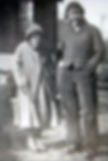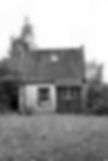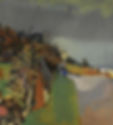Joan Eardley - Formative years on Arran
- AAHT
- Oct 25, 2022
- 8 min read
Updated: Mar 17, 2024
How did her time in Corrie on the Isle of Arran influence her later work?
In the early 1940s, a small boy of about five years old noticed a young woman standing by the tiny, picturesque Old Port in the village of Corrie on the Isle of Arran. Here the West coast “puffers” called in with their cargos before moving on to other island communities, and with a row of white cottages behind and the open sweep of the Clyde before, the view was colourful, textured and ever-changing. The woman who caught the eye of the Corrie school boy was standing, looking out to sea, with her easel in front of her, and he didn’t recognise her as a village resident. He noticed her casual and unconventional clothing - baggy trousers, a “too big” jacket – and he concluded that she was a “poor woman” who looked “like a tramp”. Thoughtfully he approached the artist and, considering her to be in greater need than himself, he kindly offered the stranger his pocket money.
Young Bob Lees didn’t know the woman at the port who so prompted his sympathy, and we don’t know what she felt when the small hand proffered the coins (hopefully she found some humour in the exchange), but we do now know that she was Joan Eardley, who has since been called “One of the great British artists of our time” (Cordelia Oliver). Joan had a relatively short career, dying aged just forty two and leaving a bounty of original works that continue to enchant to this day, and Bob made his kind offer when her career was just beginning, and when she first started visiting, and depicting, life and landscape on the Isle of Arran.
Although born in Sussex, Joan moved to Glasgow as a child and developed an inexhaustible passion for her new country, spending most of her life exploring both rural and urban aspects of Scottish identity through mixed media and paint. She is famous for her mature works in the tenements of Glasgow and on the wild Aberdeenshire coast near the village of Catterline, but my interest here is in her early work while she was a student, learning and refining her craft. Many accounts of Joan’s life skip quickly over her time spent on the Isle of Arran during these years, yet this is when she was discovering themes, methods and techniques to which she would return throughout her life.
There are few pieces left from this early stage of Joan’s career, and much of her work is unsigned and undated, so identification can be difficult, but what is undisputed is that Joan did visit Arran a number of times during the early 1940’s (exactly when and how often is not documented) and I hope to show that her experience there contributed much to her future development as an artist.
CORRIE

When staying on Arran Joan was based in Corrie: a small coastal community on the East coast, where visitors find a verdant coastal landscape with raw, warm sandstone and pretty white cottages topped by a wide horizon. The challenge of constantly changing light and colour, plus the hospitality of the local cottage owners who rented accommodation to visiting artists, assured the twin villages of
Corrie and High Corrie a place in Scottish art history as an important creative destination. Jessie M King was inspired to set up an art school in High Corrie, and the area attracted famous visionaries such as John Maclauchlan Milne, and Margot Sandeman.
It was Margot Sandeman who introduced Joan Eardley to the delights of Corrie during her student years when they were studying together at the Glasgow School of Art. Margot’s artistic family already had a love of Corrie, and after being invited to join them in the summer of 1942, Joan returned to the village a number of times during the early part of the decade. Joan and Margot were already good friends before their first trip to Arran together, pursuing very different artistic goals yet sharing a love of the rural landscape. The two young women developed a deep fondness for the village and for the artistic freedoms they enjoyed there, and Joan’s many letters to Margot throughout her life often reference Corrie. Later in their careers in 1951 Joan still clearly thinks of Corrie and the experience of painting there, advising Margot in a letter: “…you now should go to Corrie and paint what you feel like there.....These kind of goings away are entirely necessary for me”
In that summer of 1942, when Joan first rode the ferry to Arran, she was already forming a style of her own, under the tutelage of Hugh Adam Crawford at Glasgow, absorbing the influence of Moore and Epstein in her use of strong line and monumental forms. Few of her early works remain, but a prize winning portrait of the era exhibits a free and confident use of colour, and through her study of drawing at Glasgow she became a fine draughtsman, exhibiting a powerful sense of line and texture. Joan’s subjects during the early years in the 1940s were down to earth, everyday scenes and sturdy characters, and these characteristics extended to her work in Corrie and to the formation of her style.
Corrie Life
Whilst staying in Corrie, Joan and Margot rented a bothy called “the Tabernacle” which was set in the grounds of a village house called “Hillcroft”. The Tabernacle is still standing: it is a tiny two storey space, which could have been unhospitable and inhibiting, but instead it offered liberation, giving the young women the freedom to come and go as they pleased. Joan befriended her elderly neighbour Mrs Jeannie Kelso, also known as Wee Jeannie, “taking her under her wing” according to one villager. Jeannie, her way of life and dress, became a regular model for Joan’s pen and ink studies, as did the cosy, cluttered domestic cottage interiors, particularly highlighting kitchen ranges and stoves.


Joan & Jeannie Kelso | The Tabernacle, Corrie | Photos by Margot Sandeman
These studies surely were the inspiration for Joan’s striking, densely coloured portrait “Mrs Red Wallpaper” exhibited in 1948. Painted in Lincoln, it references the studies of Jeannie Kelso and the practical Corrie interiors that Joan so enjoyed observing.
These early interests which she pursued in the village, demonstrate Joan’s compassion for the vulnerable and dispossessed, and her eye for character. Her work through the 1940s found beauty in the commonplace and the ordinary, with Glasgow workmen, busy street and harbour scenes and Italian peasants observed in paint, pastel and line drawing. Her later celebrated paintings of Glasgow tenement children were colourful empathetic portraits, reflecting a life of impoverishment, yet unsentimental and full of personality. This early interest in social realism and the observation of a way of life, plus the vagaries of human character and costume, was seeded in Corrie with her interest in the spirit of village life, home and personalities.


Mrs Red Wallpaper Exhibited 1948 Kitchen range. Pen and ink. Estate of Joan Eardley
Corrie character
Joan was a singular character who was certainly noticed when working around the village, but sadly few locals remain who can lay claim to knowing her at this time. As well as Bob Lees and his recollection of the “poor woman” at the Old Port, another resident who was a child in the early 1940s, recalls the artist as notable for being a rather shabby, informal character. Dressed “differently” according to the young observer, in” trousers and a long coat” Joan dressed to be practical in contrast to the more tailored and feminine fashions for women of the 1940s.
Anecdotally, Joan was described as stand-offish, not indulging in small talk, and she can be seen as lone figure, single minded and fully absorbed in her art. She was not part of a group of artists, although she had close friends, going her own way in life and her art. The vision of the artist as casual and “tramp like” explain how her character was tightly bound with her work: during her time in Corrie Joan started expressing on canvas the drama and urgency of the scene before her. Capturing the movement of weather systems and waves, and textures of rocks, shingle and trees, filtered through the changing colours of the Corrie atmosphere, required practical dress of simple comfort and warmth.

Along with her studies of domestic interiors, Joan started producing ink and pastel sketches of the exteriors of the Corrie cottages, and the honest depiction of these modest buildings was to become a favoured subject which she continued to explore and develop later when living and working in Catterline. Her early drawing (below) of a low row of coastal cottages in Corrie demonstrates that her interest in the foreground
textures of stone, shingle and wood is as
great as the requirement to portray the buildings. Her later pastel study in Catterline has become more confident: abstracted and loose in handling, the pastel strokes create a vortex of blurring land and sky, while the small dwellings sit snug into the ground, familiar refuges from the Scottish weather.


“Old Port Corrie”. Early 1940s Pen ink and pastel “Catterline Cottages,” c. 1954-57, pastel Corrie landscape and shore. c. Estate of Joan Eardley
Although the method of working “en plein-air” was well established in the nineteenth century through the work of the Impressionists, Joan took the notion of working direct from the outdoor subject to another level. Not giving in to Corrie’s frequently changing weather, or reverting to studio work, Joan would paint the immediacy of a scene directly on canvas or board, regardless of the climatic conditions. In a letter to Margot of 1944 she explains “deluges of rain came on and I felt absolutely fed up, and then I suddenly thought that I wasn't going to be beaten by the blasted rain again”. Her solution to the Scottish weather was to tie herself to her board, weighted down with stones, and working on through rain and storms.
Joan painted what is generally accepted as her first seascape whilst staying in Corrie. The oil on canvas “The shore, Corrie” captures the wild, un-manicured essence of the shoreline from an eccentric viewpoint, taking the eye along the edge of the greensward with overhanging bracken, towards the port, where a hint of blue suggests a moored fishing boat. The stormy, atmospheric colours are rain-laden, yet a sudden burst of light in the distance suggesting a coming change in the weather.
Sothebys in their catalogue note of 2009 state that “the…work can be can be seen as an important precursor to the landscapes she painted a decade later for which she became so well known” and Joan did apply this direct, elemental technique, first practiced in Corrie, later in her career. She used the same energetic, expressive paintwork, liberally applied rich colours and unconventional perspectives to create her dynamic visions on the coast by Catterline, dashing away from Glasgow at the first hint of a bad weather on the East coast so she could paint in the eye of the storm.


The Shore, Corrie, Arran c Gerber Fine Art | July Fields, circa 1959 | c Estate of Joan Eardley
Corrie’s importance
There seems no doubt that Joan’s early experience of life and work in Corrie profoundly impacted on her later artistic and life choices. Maybe, if she had not been introduced to the island by Margot and had not discovered, then portrayed, the seductive landscapes, diverse coastline and village life of Corrie, she may have been inspired by other subjects and methods. But fate took her to the shores of Arran and she felt the need to keep returning through the first half of the 1940s, bonding with the place and determinedly pursuing her developing artistic ideas. “The more I know a place the more I find to paint” Joan said in 1961: she was talking about Catterline, the second important Scottish village in her career, but she could well have been speaking of Corrie. Here she found the freedom to explore and experiment and was freed from convention in artistry and the way she chose to live her life. Joan’s drawing skills and expressive painting technique were enhanced,
extended and modernised on the Corrie shore as she reached towards the celebrated methods that now mark her out as a great Scottish modernist.
Sandra Murphy
For The Arran Arts Heritage Trail May 2021
With thanks to the following:
Bob Lees, Pamela McConnachie, Gordon Davidson, Ronnie Logan, Stephen Moles
www.arranartsheritagetrail.com




